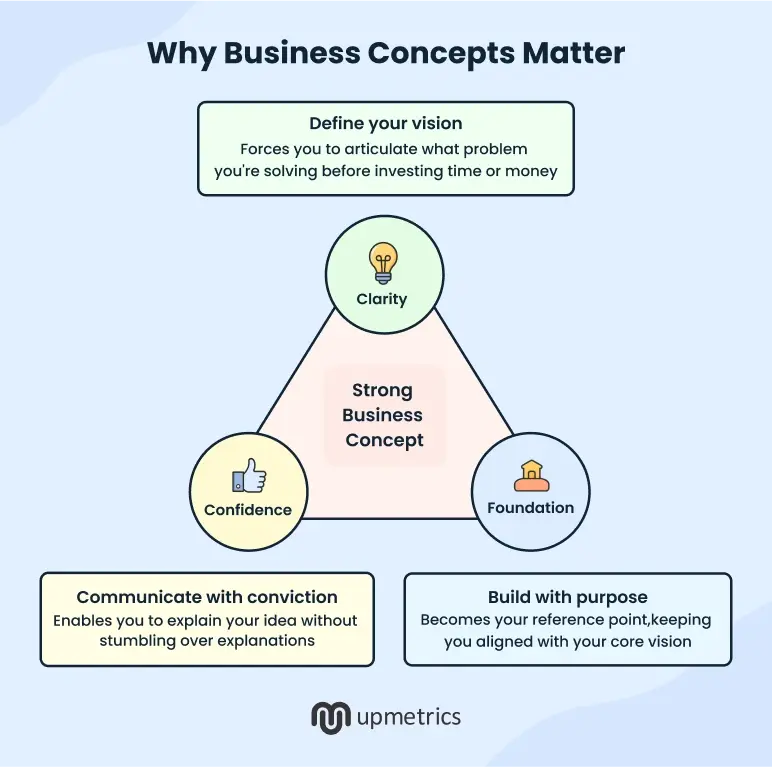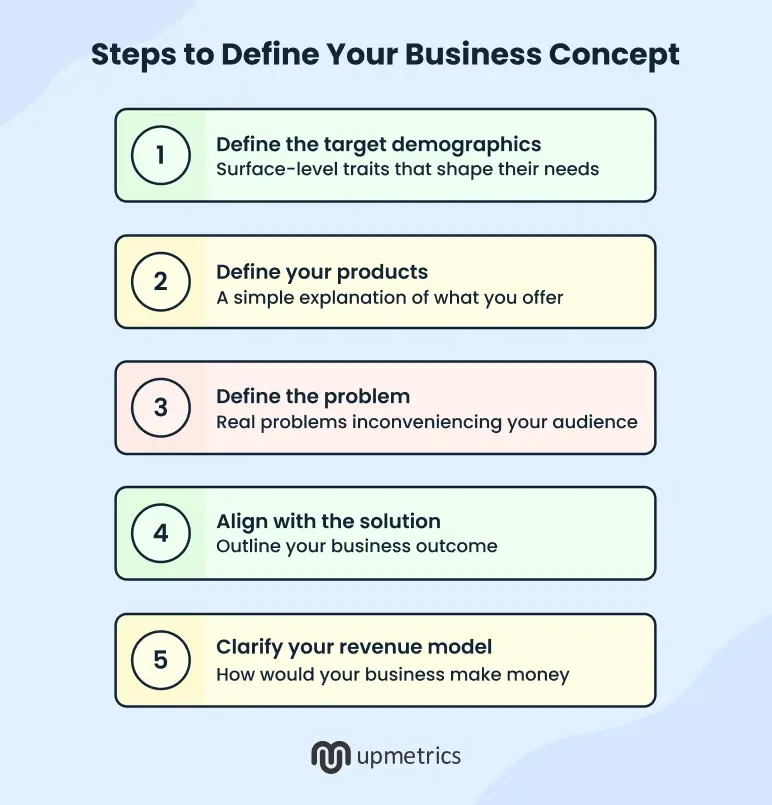I’ve been working with entrepreneurs for over a decade, and there’s one thing that entrepreneurs of every “about to turn successful startups” have in common.
They have a crystal-clear core.
They don’t hide behind fancy jargon or obsess over their tech stack. When someone asks what their business does, they give you a straight answer instead of rambling for 10 straight minutes.
That’s exactly what your goal should be: Ridiculous simplicity.
You must have a clear problem, a concrete solution, and a straightforward way of making money in your business before you dive into anything else.
This foundation (the crystal-clear core) is what we call a business concept. And it’s more important than your business plan or your pitch deck.
With this blog, let’s help you understand everything that you need to know about getting your business concept right.
What is a business concept?
A business concept is your core business idea stripped down to its essential elements. It lays a successful groundwork for why an idea exists, what it aims to achieve, and if it’s a viable business idea to invest in. It’s a foundation upon which you build your business plan.
A solid business concept helps you test and validate your ideas before you get into pitching and building. Without a grounded vision, you are likely to lose direction when challenges arise. Your concept keeps you focused on what matters the most, i.e., solving a real problem.
Don’t build your business in isolation
Validate your business idea with one-page business plans
Plans starting from $14/month

Why is a business concept important?
Too many entrepreneurs jump straight into building a business without understanding what they’re actually creating or who wants it.
The result?
Nearly 20-24% of businesses fail in the first year itself.
A clear business concept won’t fix everything, but it could prevent a lot of that. Here’s how:
Clarity
Building a business concept forces you to define your idea before you invest time or money. It distills your vision down to the essentials—what problem you’re solving, and for whom. That clarity helps you avoid building something nobody needs.
Confidence
You don’t need to spend hours explaining the core of your business to the partners and potential stakeholders. At least not initially. And that’s exactly what a concept helps with. It enables you to explain your idea to others with conviction without stumbling over explanations.
Foundation
Your concept becomes the reference point for everything you plan later. Whether you’re adding features or considering partnerships, it’s easier to decide what fits when you’ve already nailed down the core idea. A strong concept gives you a focus to align your choices with your bigger vision.

That said, a clear concept keeps you grounded when things inevitably get complicated.
Business concept and business plan aren’t the same
A business concept and a business plan quintessentially sound the same to entrepreneurs who haven’t planned before. And with lean plans becoming mainstream, this confusion grows even stronger.
Well, a business concept is the core of your business idea. It offers a quick snapshot of your product offerings, key demographics, and the value proposition without diving into details. It’s just the length of a paragraph.
A business plan, on the other hand, includes a detailed explanation of every facet of a business. This includes the buyer’s persona, marketing strategies, business operations, hiring strategies, growth plans, and financial overview explained over a couple of pages.
To simplify, think of a concept as a sketch that helps you build an execution blueprint (business plan). While a concept offers foundation and clarity, a business plan transforms that foundation into an actionable strategy.
Key elements of a business concept
A business concept is built on a few foundational blocks. Even if these details evolve later, it’s important to define them upfront to stay focused on what matters.
A strong concept typically covers the following key elements:
- Product/Service: Clearly define what you are selling, whether it’s a physical product, digital service, or experience that people will pay for
- Target market: Your target audience—think demographics, behaviors, and circumstances that make someone likely to need what you’re offering
- Problem: This (frustration, inconvenience, or pain point) should be something people actively experience and would pay to solve
- Solution: How does your product or service actually fix that problem, i.e., what changes in your customer’s life after they use your solution?
- Revenue model: Clarify your basic approach to making money, i.e., subscriptions, one-time purchase, service-based pricing through a website, physical location, mobile app, or direct service
- Delivery method: How will customers access and use your offering, i.e., through a website, physical location, mobile app, or direct service
Mention that these can evolve later, but defining them upfront gives you a strong foundation.
How to define your business concept?

Let’s now help you translate your business ideas into a solid business concept.
Step 1: Start with the customer
Define the categories of customers you would be serving. And no, you don’t get into depth creating a buyer’s persona for each profile. Instead, here you just focus on surface-level traits that shape the needs of your targeted demographics.
You can start by asking yourself these questions about your targeted demographics:
- What do they do for work, or how do they spend their days?
- Where do they live or spend most of their time?
- What matters most to them right now?
- What’s their general income level or spending capacity?
The more specific you get, the clearer your concept becomes.
For instance, “Small business owners” is too broad a category to target. However, “Restaurant owners in tier 2 cities struggling with staff scheduling” gives you something concrete to work with.
Step 2: Describe your product or service
List your core offerings—the things people will pay you for. It could be food delivery, CRM software, coaching sessions, or cleaning services.
You’re not explaining how it’s built or delivered. Just what you offer, in plain terms.
Avoid technical terms or insider lingo. If someone outside your field wouldn’t get it, it’s too complex.
Instead of “AI-powered B2B SaaS workflow optimizer,” say “an app that helps teams organize tasks faster.”
Step 3: Identify the problem it solves
What’s frustrating, inconvenient, or costly for your customer right now? Focus on problems they’re actively facing—not just ones you think they have.
This is where you sanity-check your assumptions. Talk to real people or observe behavior to confirm the problem exists.
For instance, instead of assuming “small gyms need a better app,” find out if they’re actually struggling with class bookings, late payments, or member retention. The more real the problem, the easier it is to build something useful.
Step 4: Connect it to a solution
How does your offering actually solve that issue or improve their life? This should connect directly to your product.
Ask yourself:
- What changes for the customer after using your product or service? (e.g., they no longer miss appointments)
- Does it save them time, money, or effort? (e.g., they don’t have to chase late payments)
- Does it remove stress or solve a recurring headache? (e.g., fewer no-shows, faster checkouts, better sleep)
Saying “we offer automated reports” is a feature. Saying “we help managers spot issues early without digging through data” is an outcome.
This is the outcome your business concept should include.
Step 5: Think about how it will make money
Clearly outline how your business will generate revenue. Will it come in monthly, once per purchase, or only when a service is used?
Now, there are different revenue business models—and each fits different types of businesses:
| Revenue Model | When does it work the best? |
|---|---|
| One-time purchase | Physical products, software license |
| Subscription | Ongoing services, software access |
| Per-use transaction | Services used occasionally |
| Advertising/ freemium | High user volume needed |
This is a part of a business concept where you outline your basic revenue model—without getting into projections or complex pricing.
Step 6: Keep it simple
Can you sum up your entire concept in a few sentences that anyone (even outside your industry) can understand? If yes, you’re ready. If not, go back and edit your business concept for enhanced clarity.
The simpler your business concept, the better it will guide you while writing your business plan.
A business concept can (and probably will) evolve as you gather more information or test your idea. So your answers at this stage don’t have to be final or set in stone. Just don’t let it sit under wild assumptions
Stop building your business on assumptions
Validate your business idea quickly with a single-page plan
Plans starting from $14/month

5 Common mistakes to avoid
Entrepreneurs do make some predictable errors when defining their business concept. These mistakes often lead to concepts that don’t connect with real customers.
Well, here’s what to watch out for:
- Skipping the customer problem entirely: Getting excited about your solution is natural, but if you don’t focus on the problem that people are actually facing, your concept will lack context and depth
- Overcomplicating your core idea: avoid the urge to include every minute detail or use a lot of industry jargon—you will get an opportunity to expand on your ideas while writing a business plan
- Assuming you know your customers: Thinking you understand your audience without actually talking to them or researching their current behavior
- Trying to serve everyone at once: Everyone isn’t your market, so if you are trying to be likable and accommodating for everyone, your concept would turn too broad and generic
- Jumping straight to branding and logos: Spending a little too much time on visual identity rather than instilling clarity in what you’re actually offering and why people need it
Business concept examples
Let’s now look at a few business concept examples for extremely diverse businesses. Each one of these follows a simple structure that you can use to write your own concept:
Example 1: Tech/SaaS – AI-driven resume builder for job seekers
- Industry: Career services technology
- Target customer: Mid-level professionals (3-8 years experience) changing careers or seeking promotions
- Problem: They struggle to tailor resumes for different roles and don’t know which skills to highlight for specific industries
- Solution: AI analyzes job descriptions and automatically customizes resumes, suggesting relevant keywords and restructuring experience to match employer expectations
- Revenue model: Freemium with $19/month for unlimited customizations and cover letter generation
- Delivery channel: Web application with mobile optimization
Example 2: Product – Plant-based protein snacks for athletes
- Industry: Sports nutrition and fitness
- Target customer: Amateur and semi-professional athletes following plant-based diets
- Problem: Most protein snacks contain dairy or animal products, and plant-based alternatives often taste bad or have poor texture
- Solution: Ready-to-eat protein bars made from pea and hemp protein that taste like traditional energy bars but provide 20g of plant protein per serving
- Revenue model: Direct-to-consumer subscription boxes ($39/month for 30 bars) plus retail partnerships
- Delivery channel: E-commerce website with monthly subscriptions and select gyms/health stores
Example 3: Service – Mobile pet grooming service for urban dog owners
- Industry: Pet care services
- Target customer: Busy professionals in dense urban areas who own medium to large dogs
- Problem: Traditional pet grooming requires scheduling around business hours, driving across town, and leaving pets in stressful environments with other animals
- Solution: Professional grooming services that come directly to customers’ homes or offices, providing full-service grooming in a custom van
- Revenue model: Per-service pricing ($75-120 based on dog size) with package deals for regular customers
- Delivery channel: Mobile app for booking and GPS tracking, plus phone scheduling
Transform your business concept into a business plan
When you’re building a business from scratch, it’s easy to lose focus with strategies, marketing, operations, and product decisions pulling you in different directions. A clear business concept helps you block out noise and avoid costly missteps.
Now, once you have your concept ready, turn it into a comprehensive business plan with Upmetrics. You get every resource essential to help you make this smooth transition—an AI-powered business plan generator, proven business plan samples, and an intuitive forecasting tool suitable even for beginners.
Don’t spend months trying to build an actionable plan for your business. With Upmetrics, build quickly, test even quicker, and make adaptations on the go.


